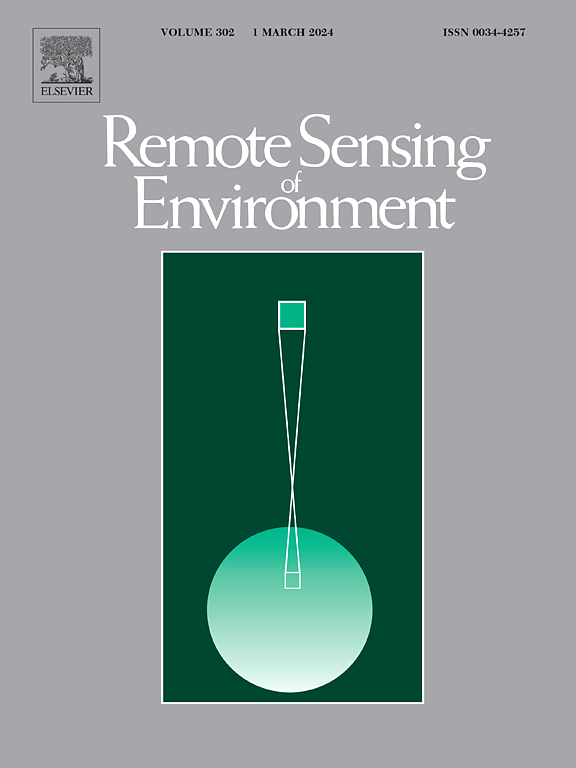Spatiotemporal evolution characteristics of ground deformation in the Beijing Plain from 1992 to 2023 derived from a novel multi-sensor InSAR fusion method
IF 11.1
1区 地球科学
Q1 ENVIRONMENTAL SCIENCES
引用次数: 0
Abstract
The Multiple Temporal Interferometric Synthetic Aperture Radar (MT-InSAR) technology is capable of effectively generating ground deformation information derived from high-precision and continuous observation by satellites. However, due to the limited operational lifespan of a single SAR satellite, the derived ground deformation result of the study area cannot be ensured long-term (several decades), and merely a few years. With the increasing number of SAR satellite launches, it has become possible to conduct long-term continuous monitoring of ground deformation by combining data from multiple platforms. Nevertheless, several existing methods (e.g., model fitting method, predictive splicing method, etc.) have lower fusion accuracy and are limited to specific deformation patterns. In this study, a Piecewise Exponential Fitting with Weighted Average (PEFWA) method is proposed, which takes into account both the trend and accuracy of the preceding and following deformation time series in the fusion. The experimental results on the simulation data prove that the accuracy and robustness of this method are higher than several other methods. We applied the proposed method to characterize the evolution of ground deformation in the Beijing Plain from 1992 to 2023 using data from four different SAR satellites. The results show that: (1) With the implementation of various policies (e.g., the South-to-North Water Diversion Project, the Ecological Water Replenishment Project, etc.), ground subsidence has generally followed a trend of “worsening initially, then improving”. (2) The spatial variability of ground subsidence is primarily influenced by the locations of fault zones. (3) The periodic changes in the ground deformation time series are mainly driven by fluctuations in groundwater levels. The above findings indicate that the method proposed in this study can effectively integrate deformation series with temporal discontinuities, which helps detect the long-term trends and formation mechanisms of ground deformation.
基于InSAR多传感器融合方法的1992 - 2023年北京平原地表变形时空演变特征
multi - Temporal Interferometric Synthetic Aperture Radar (MT-InSAR)技术能够通过卫星的高精度连续观测有效生成地面变形信息。然而,由于单颗SAR卫星的使用寿命有限,无法保证研究区导出的地面变形结果的长期(几十年),而仅仅是几年。随着SAR卫星发射数量的不断增加,结合多平台数据对地面变形进行长期连续监测已成为可能。然而,现有的几种方法(如模型拟合方法、预测拼接方法等)的融合精度较低,且仅限于特定的变形模式。本文提出了一种同时考虑前后变形时间序列趋势和精度的加权平均分段指数拟合(PEFWA)方法。在仿真数据上的实验结果表明,该方法的精度和鲁棒性都高于其他几种方法。利用4颗不同的SAR卫星数据,对1992 - 2023年北京平原地面变形的演化特征进行了分析。结果表明:(1)随着南水北调工程、生态补水工程等各项政策的实施,地面沉降总体上呈现“先加重后好转”的趋势;(2)地表沉降的空间变异性主要受断裂带位置的影响。(3)地表变形时间序列的周期性变化主要受地下水位波动驱动。上述结果表明,该方法可以有效地将变形序列与时间不连续相结合,有助于探测地表变形的长期趋势和形成机制。
本文章由计算机程序翻译,如有差异,请以英文原文为准。
求助全文
约1分钟内获得全文
求助全文
来源期刊

Remote Sensing of Environment
环境科学-成像科学与照相技术
CiteScore
25.10
自引率
8.90%
发文量
455
审稿时长
53 days
期刊介绍:
Remote Sensing of Environment (RSE) serves the Earth observation community by disseminating results on the theory, science, applications, and technology that contribute to advancing the field of remote sensing. With a thoroughly interdisciplinary approach, RSE encompasses terrestrial, oceanic, and atmospheric sensing.
The journal emphasizes biophysical and quantitative approaches to remote sensing at local to global scales, covering a diverse range of applications and techniques.
RSE serves as a vital platform for the exchange of knowledge and advancements in the dynamic field of remote sensing.
 求助内容:
求助内容: 应助结果提醒方式:
应助结果提醒方式:


